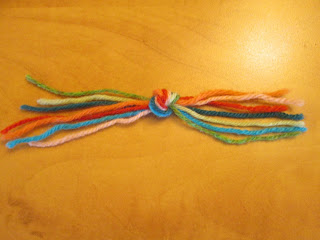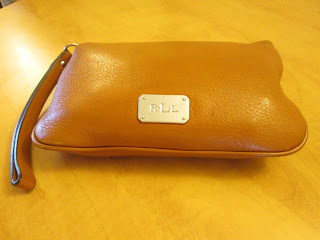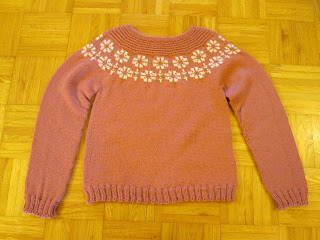I had just 10 grams left over of the newly purchased olive yarn, and I used approximately 10 grams of each of the rainbow coloured stash yarn (or 70 grams), so that's a net stash decrease of -60 grams.
Friday, September 24, 2021
I Heart Olivia
I had just 10 grams left over of the newly purchased olive yarn, and I used approximately 10 grams of each of the rainbow coloured stash yarn (or 70 grams), so that's a net stash decrease of -60 grams.
Wednesday, August 25, 2021
A Gem of a Hat and Scarf Set
Tuesday, June 15, 2021
An All Generations Sweater
And, because a wool sweater is not an exciting gift for an boy turning eight in July, I added a few dollar store trinkets: a scavenger game that can be played in one's house, and two Hot Wheels miniature cars.
This project used 2 grams of cream Drops Karisma that I had left over from another project, and there were 10 grams of cream and 15 grams of charcoal left over from the new yarn that I bought for this project, so that's a net stash increase of 23 grams.
Tuesday, May 11, 2021
The Lovely Orchard Quilt
The finished quilt. It turned out very well and I am pleased with it. The 42" x 79" size was not quite what I had expected at the outset, but it will do. It can be used as a blanket on Olivia's single bed.
Making the coronavirus quilt felt like a herculean effort and it took me ten months to take the project from start to finish last year, though of course I wasn't working at it at all regularly during those months, but only in starts and fits. That wasn't at all my experience this time. Olivia's quilt took me just thirteen days start to finish, and I worked at it an average of two hours a day. On day one, I pieced the leftover pieces of Thinsulate together, cut two lengths of the print, and pinned the layers together. On days two to eight, I stitched the body of the quilt in vertical lines a half-inch apart. On day nine, I prepared the binding and squared the quilt by trimming the edges evenly. On day ten, I machine stitched the binding in place, flipped it over and pinned it to be hand-sewn on the other side of the quilt, and began the hand sewing. On days eleven through thirteen, I did the remaining hand sewing.
The whole process was so straightforward and unproblematic that it amazed me. When I was making the first quilt, I struggled a lot with having to laboriously rip out lines of quilting because the fabric had puckered or folded on the underside. That never happened while I was stitching the body of this quilt -- not even once. Of course, this was an easier project because it was far less work. The coronavirus quilt had a finished size of 78" x 83.5", its quilting lines were 3/8" apart, and I put in over 240 vertical lines of stitching into its body. This quilt has a finished size of 42" x 79", its quilting lines are 1/2" apart (or a hair less), and I think there were 92 vertical lines of stitching in it. This second quilted blanket required not only well under half the actual sewing of the first, but was also far lighter, which made it considerably easier for me to physically control the fabric as I ran it through the machine. But I think the experience I gained in working on the first one contributed just as much to making this second project go so much more smoothly and efficiently. I knew exactly how to hold the quilt so that it wouldn't pucker on the underside, and there was no months' long stall of the project while I put off the task of binding the finished body because I was intimidated by the prospect of learning how to make binding and put it on.
When I finished the coronovirus quilt, while I knew I would be making the second smaller quilted blanket for Olivia in order to get that Thinsulate used up, I thought I would probably never make a third. Now I find I'm open to making another quilted blanket at some point. I've had that coronavirus quilt on my bed since last October, and I have been so grateful for it all through Toronto's 2020/2021 winter weather. One of my physical quirks is that I am extraordinarily cold resistant during the day -- strangers sometimes approach me on the street, look significantly at what I'm wearing, or rather not wearing, and say, "Aren't you cold?!" -- but that seems to change radically as soon as I get into bed at night, when I turn into some kind of freak icicle-human hybrid. Before this past year, during the winter, I would have on my bed a top sheet, a quilt, two wool blankets, a fleece blanket, and a duvet in a velvet cover... and it still wasn't enough to keep me from shivering miserably. During the coldest months I would have to spread on top of my duvet not only the afghan from the foot of my bed but also the afghan from the guest room and the faux fur throw and woven throw from the living room couch. This year I had on my bed the top sheet, the old quilt, the new coronavirus quilt, two wool blankets, and the duvet, and sometimes the afghan from the foot of my bed, and that was sufficient. The fleece blanket remained on a shelf in the linen closet and the guest room afghan and living room throws stayed in their places. In other words, that one lightweight Thinsulate quilt took the place of four other layers.
Now that I know I am confident I can turn out a quilted blanket in such good time, and that a Thinsulate blanket is an excellent thing to have, I am open to making more in future, should I have need for another quilt for my household, or want to make one for a gift. Twenty-six hours of work does not seem to me like an unreasonable amount of effort to put into such a practical item that will last a decade or more.
I'd originally planned to give Olivia the quilt as part of her Christmas 2021 present, but when I finished it in time for her 5th birthday, which is today, I decided it would become part of her birthday present instead. Of course the rest of her birthday present was more geared to the tastes and interests of a 5-year-old girl than this quilt is. Childless old maid as I may be, I'm not so out of touch as to think a child her age is going to find a quilt an exciting birthday present.
I have something like 1.3 metres of the Lovely Orchard fabric left, and I've tucked it carefully away in my remnant fabric drawer. I don't have a plan for its use yet, but knowing me I am sure inspiration will strike at some point. And I'm looking forward to working with such a charming print again. As for the Thinsulate... I have just two small pieces left, and they've been tucked away in my drawer of interfacings and linings. Maybe I'll make a pair of mittens out of them sometime.
Something to Wear, Something to Read, Something to Play With
Sunday, May 9, 2021
Brave New Bag

 In the fall of 2020, I faced the fact that my beloved Everlane backpack that I had been using nearly daily since I bought it in late 2014 was getting so much the worse for the wear that I was embarrassed to be seen with it. One of the snaps that fastened the top flap was broken, and I couldn't find any snaps of the right weight to replace it. The bottom was ragged. The canvas that formed the body was dirty, and though I would try to spot clean it, that wasn't doing the trick, and, as the bag had leather trim, it wasn't feasible to dry clean it. (When I made inquiries, the dry cleaner told me it would cost $100 to have my $75 bag cleaned, and that they couldn't guarantee the results.) I came up with the idea of taking the backpack apart and using it as a pattern to make a new bag, for which I could use all the buckles and leather straps and trim from the old one. My inability to find replacement snaps stymied that plan. I still hope to eventually find a way to remake my old Everlane backpack, but in the meantime, I needed a presentable bag for everyday wear. It was time for a new bag.
In the fall of 2020, I faced the fact that my beloved Everlane backpack that I had been using nearly daily since I bought it in late 2014 was getting so much the worse for the wear that I was embarrassed to be seen with it. One of the snaps that fastened the top flap was broken, and I couldn't find any snaps of the right weight to replace it. The bottom was ragged. The canvas that formed the body was dirty, and though I would try to spot clean it, that wasn't doing the trick, and, as the bag had leather trim, it wasn't feasible to dry clean it. (When I made inquiries, the dry cleaner told me it would cost $100 to have my $75 bag cleaned, and that they couldn't guarantee the results.) I came up with the idea of taking the backpack apart and using it as a pattern to make a new bag, for which I could use all the buckles and leather straps and trim from the old one. My inability to find replacement snaps stymied that plan. I still hope to eventually find a way to remake my old Everlane backpack, but in the meantime, I needed a presentable bag for everyday wear. It was time for a new bag.- wallet
- keys
- a small notebook and pen
- my planner (usually)
- camera (sometimes)
- a measuring tape
- a folded tote bag
- compact umbrella
- sunglasses
- cough drops
- tissues
- a water bottle (in summer)
- a vanity case containing a manicure kit, compact, pill box, hand lotion, lip balm, hair pins, a comb, and tampons
In the back outside pocket of my bag, I carry a little notebook and a pen for those moments when I need to jot something down right away. The notebook was a dollar store purchase, and it's such a lovely little thing and such a perfect accessory for this bag that I almost hated to write in it. Where was I ever going to find another as nice? I went back to the store and bought two more of these notebooks, so I won't have to worry about finding another perfect little notebook for my bag for quite some time.
This is my ARC planner, with the pen -- a refillable wooden one made for me by my father -- that I keep in its pen slot. I've been using the ARC system since 2013, and am still so glad I discovered it. It was the good-looking, durable, customizable, re-fillable planner I'd been looking for for since I was a teenager. I did run into one snag in that Staples Canada doesn't carry the annual calendar refills that make the system useful, but I got around that, first by making arrangements with one of my American friends to buy and ship me one every year, and then in late 2019 I invested in an ARC hole punch, made a set of laminated monthly tab dividers, and began printing my own refills. So even this planner is partially handmade. And of course, it goes with my bag.
The tote bag is a dark brown nylon on one side, and a lighter brown check on the other. It's a reversible bag, so I'll be able to use whatever side looks better with my outfit. This bag has such a nice stylish shape, too. I made it according to the pattern in this excellent tutorial. I've made this type of bag before and am certain I will make another at some time in the future.
Thursday, April 15, 2021
Spool School
I have a few more thread inventory management tips to share. One, if you do a lot of sewing, it may be worth buying cones in a few basic colours, or in colours you like a lot and tend to work with often. Cones are less expensive than spools, you can rest secure that you won't run out mid-project, and thread keeps indefinitely. I like to keep cones on hand in black, white, brown, ivory, red, and navy. I've been through at least a few cones in each colour in my more than two decades of regular sewing. I also have cones in charcoal and bright pink that I bought nearly 20 years ago when I had one project to do in each colour and I happened to see the cones on sale, and buying those wasn't a good idea. I don't wear gray or pink at all, and am unlikely to ever use them up.
Which leads me to my next tip: if you have a very small amount left on a spool, or a colour of thread you used for just one project and are probably not going to ever need or want again, use that thread for basting. Basting with a contrasting colour of thread you will never otherwise use will make your "good" thread go farther, and it will also make it easier for you to see, and remove, your basting threads.
Besides my 32-spool rack pictured at the top of this post, I have a small cardboard box where I keep most of the rest of my spools, which have been designated as basting thread. I've been using my designated basting threads system for a year or two, and I'm gradually whittling my spool collection down in size. Eventually I hope to have all my spools fit on the rack. A collection of 47 spools and 8 cones does take up more room than I would like.
And my final pro-tip regarding your thread collection management: don't let your cat have unsupervised access to your sewing area. My Trilby loves to play with spools of thread. And they must have thread on them -- I have tried to give him empty spools to play with, and he had no interest. No, his spool play has to involve inconveniencing or exasperating me in some way.
One time Trilby managed to get a spool so wound around every item in the attic that it must have taken me 10 minutes to wind it back up again. On one other occasion, I spent 25 maddening minutes looking for a spool of taupe thread that I knew I had on my sewing table and just couldn't seem to find though I'd looked in every conceivable place that I could have possibly put it. Finally I gave up and bought a new spool of thread in that colour, only to find the first one under the plant stand I had in the kitchen when I was vacuuming a few days later. Trilby had chased that spool of thread down the attic steps, along the second floor hallway, down the main staircase, along the first floor hallway, and into the kitchen, before ultimately getting the spool stuck under the plant stand. This is why I now have two spools of taupe thread in my basting thread box, and why Trilby is not allowed to be in the attic by himself.
Don't even get me started on Trilby's fetish for pearl-headed pins, as that is beyond the scope of this post.
















































